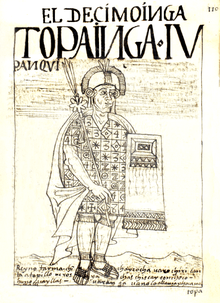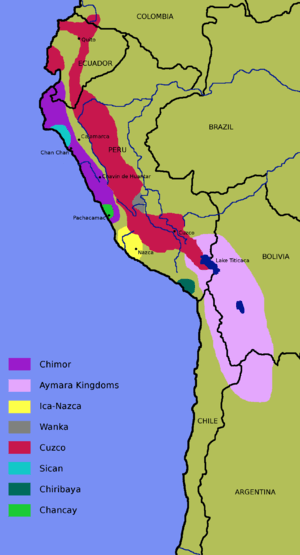Topa Inca Yupanqui
| Topa Inca Yupanqui | |
|---|---|
| Sapa Inca (10th) | |
 Drawing by Guaman Poma in 1615 | |
| Reign | 1471–1493 |
| Full name | Túpac Inca Yupanqui |
| Quechua | Tupaq Inka Yupanki |
| Spanish | Túpac Inca Yupanqui |
| Predecessor | Pachacuti |
| Successor | Huayna Capac |
| Dynasty | Hanan |
| Father | Pachacuti |
Topa Inca Yupanqui or Túpac Inca Yupanqui (Quechua: Tupaq Inka Yupanki),[1] translated as "noble Inca accountant," was the tenth Sapa Inca (1471–93) of the Inca Empire, and fifth of the Hanan dynasty. His father was Pachacuti, and his son was Huayna Capac. Topa Inca belonged to the Qhapaq panaca (one of the clans of Inca nobles).[2]
Description

His father appointed him to head the Inca army in 1463. He extended the realm northward along the Andes through modern Ecuador, and developed a special fondness for the city of Quito, which he rebuilt with architects from Cuzco. During this time his father Pachacuti reorganized the kingdom of Cuzco into the Tahuantinsuyu, the "four provinces". he led extensive military conquests to extend the Inca empire across much of Southern America.
He became Inca in his turn upon his father's death in 1471, ruling until his own death in 1493. He conquered Chimor, which occupied the northern coast of what is now Peru, the largest remaining rival to the Incas.
The Pacific Expedition
Legend
Topa Inca Yupanqui is also credited with leading a roughly 10-month-long voyage of exploration into the Pacific around 1480, reportedly visiting islands he called Nina chumpi ("Fire Island") and Hahua chumpi (or Avachumpi, "Outer Island"). The voyage is mentioned in the History of the Incas by Pedro Sarmiento de Gamboa in 1572.[3] Pedro Sarmiento described the expedition as follows:
- …there arrived at Tumbez some merchants who had come by sea from the west, navigating in balsas with sails. They gave information of the land whence they came, which consisted of some islands called Avachumbi and Ninachumbi, where there were many people and much gold. Tupac Inca was a man of lofty and ambitious ideas, and was not satisfied with the regions he had already conquered. So he determined to challenge a happy fortune, and see if it would favour him by sea.…
- The Inca, having this certainty, determined to go there. He caused an immense number of balsas to be constructed, in which he embarked more than 20,000 chosen men.…
- Tupac Inca navigated and sailed on until he discovered the islands of Avachumbi and Ninachumbi, and returned, bringing back with him black people, gold, a chair of brass, and a skin and jaw bone of a horse. These trophies were preserved in the fortress of Cuzco until the Spaniards came. The duration of this expedition undertaken by Tupac Inca was nine months, others say a year, and, as he was so long absent, every one believed he was dead.
Analysis
Many historians are skeptical that the voyage ever took place. Supporters have usually identified the islands with the Galápagos Islands. It has also been suggested that one of the islands was Easter Island, where oral traditions have claimed that a group of long-eared hanau eepe came to the island from an unknown land.[4]
References
- ↑ http://www.britannica.com/EBchecked/topic/474227/pre-Columbian-civilizations/69433/The-origins-and-expansion-of-the-Inca-state?anchor=ref583719
- ↑ http://www.britannica.com/EBchecked/topic/474227/pre-Columbian-civilizations/69433/The-origins-and-expansion-of-the-Inca-state?anchor=ref583719
- ↑ See online version of the book, page 91; in English.
- ↑ The "Hanau Eepe", their Immigration and Extermination, Rongorongo.
External links
| Preceded by Pachacuti |
Túpac Inca Yupanqui 1471–1493 |
Succeeded by Huayna Capac |